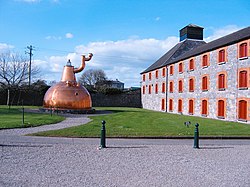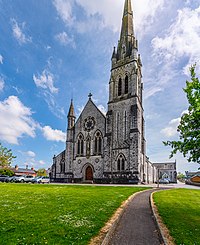Midleton
- Not to be confused with Middleton (disambiguation)
| Midleton Irish: Mainistir na Corann | |
| County Cork | |
|---|---|
 Old Distillery with copper pot still, Midleton | |
| Location | |
| Grid reference: | W879736 |
| Location: | 51°54’58"N, 8°10’30"W |
| Data | |
| Population: | 12,496 (2016) |
| Postcode: | P25 |
| Dialling code: | 021 |
| Local Government | |
| Dáil constituency: |
Cork East |
Midleton is a town in south-eastern County Cork, about ten miles to the east of Cork on the Owenacurra River as it enters Cork Harbour, and on the N25 road, which connects Cork to the port of Rosslare.
A satellite town of Cork City, Midleton is considered part of 'Metropolitan Cork' and is the central hub of business for the East Cork Area.
In the Irish language the town is given the name Mainistir na Corann, meaning "monastery at the weir".[1]
The town is located in a fertile valley below hills to the north with Cork Harbour and the coast to the south. In times past, the channel from the Harbour to nearby Ballinacurra (Baile na Cora, meaning "Town at the Weir"), was navigable by barges up to 300 tons. Due to silting over the years, the channel is now extremely shallow.
History
In the 1180s advancing Normans led by Barry Fitz Gerald established an abbey at a weir on the river to be populated by Cistercian Monks from Burgundy. The abbey became known as "Chore Abbey" and "Castrum Chor", taking its name from the Irish word cora (weir), although some say that "Chor" comes from "Choir" or "Choral". The abbey is commemorated in the Irish name Mainistir na Corann: 'Monastery at the Weir', and of the local river Owenacurra or Abhainn na Cora, meaning 'River of the Weirs'. St John the Baptist's Church, belonging to the Church of Ireland was erected in 1825 and today still stands on the site of the abbey.
Captain Walter Raleigh (later Sir Walter) had an association with Midleton, living for periods in nearby Youghal between 1585 and 1602. His presence came about due to a distribution of land in reward for helping suppress the Second Desmond Rebellion of 1579–1583. As part of this suppression he was ordered to seize Barry's Castle at nearby Cahermore. The Desmond FitzGerald Seneschal, or steward of Imokilly, on being expelled from the castle, took refuge in the Abbey, but was again forced to flee by Raleigh.
Raleigh is credited with planting the first potatoes in Europe here and also at Youghal.
The town gained the name Midleton or "Middle Town" as the main midway town, 10 miles between Cork and Youghal. It was incorporated as a market town and postal depot in 1670, receiving its charter from Charles II, as the "borough and town of Midleton". Later it would become a post town of the Great Southern and Western Railway.
Alan Brodrick, Speaker of the Irish House of Commons and Lord Chancellor of Ireland was made the first Baron and Viscount Midleton in 1715 and 1717, respectively. He is commemorated by Broderick Street in the town.
The town is home to the Old Midleton Distillery which was established by James Murphy in 1825.[2] The distillery operated independently until 1868, when it became part of the Cork Distilleries Company, which was later amalgamated into Irish Distillers in 1967.[2] In 1988, Irish Distillers was the subject of a friendly takeover by the French drinks conglomerate Pernod Ricard.[2] The Old Midleton Distillery, which boasts the world's largest pot still – a copper vessel with a capacity of 140,000 litres, was in operation until 1975 when production was transferred to a new purpose built facility, the New Midleton Distillery.[2] The New Midleton Distillery produces a number of Irish whiskeys, including Jameson Whiskey, Redbreast, and Paddy. It also produces vodka and gin. In 1992, the old distillery was restored and reopened as a visitor centre. Known as the Jameson Experience, the visitor centre hosts a number of attractions, including Ireland's largest working water-wheel (with a diameter of 23 feet).[3]
At the top of the main street stands a monument to 16 Irish Republican Army men killed on 20 February 1921 during the Irish War of Independence. Twelve of the IRA men were killed in fighting with members of the British Army at the nearby Clonmult Ambush, while four more were captured and later executed. The incident was the biggest single loss of life for the IRA during the war. 'Captain' Sean O'Shea led the Clonmult gang and is buried as head of the Republican Plot at Midleton cemetery. Nearby stands a monument marking the 200th anniversary of the Irish Rebellion of 1798.
Two houses designed by Augustus Pugin, later the architect of the Houses of Parliament in London, stand at the bottom of Main Street. They now form one building and house a public bar.[4]
In 2015, a large steel sculpture called Kindred Spirits was installed in Bailick Park. This sculpture commemorates a famine relief donation, made in 1847 by Native American Choctaw people, during the Great Famine.
Education
Elizabeth Villiers, former mistress of William of Orange, founded the private school named Midleton College in 1696. The school is traditionally associated with the Church of Ireland. Past pupils include Isaac Butt, founder of the Home Rule League, Reginald Dyer, perpetrator of the Amritsar Massacre and John Philpot Curran, lawyer and father of Sarah Curran.
Railway
Midleton railway station is on the Cork Suburban Rail network and is one of two termini (the other being Cobh) into and out of Cork Kent railway station. Passengers interchange at Cork Kent for trains to Dublin and Tralee.
The railway line to Midleton was opened on 10 November 1859 by the Cork & Youghal Railway, a company that was later taken over by the Great Southern & Western Railway. Midleton was the location of the railway works for this company.
The line between Midleton and Cork was closed for regular use between 1963 and 2009. Occasional use (mainly transport of beet from Midleton to the Mallow Sugar Factory) continued for many years after 1963, but even the sporadic usage of the line came to an end in 1988, with the final train to use the track being a passenger excursion for Midleton GAA supporters to Dublin for the final of the All Ireland Senior Club Hurling Championship (in which Midleton played). The reopening of the line was completed by Iarnród Éireann on 30 July 2009.[5]
Sport
- Cricket
- Football: Midleton F.C.
- Gaelic sports: Midleton GAA
- Rugby: Midleton RFC
- Martial arts:
- Midleton Aikido Club
- Midleton Taekwondo Club
Outside links
| ("Wikimedia Commons" has material about Midleton) |
References
- ↑ Mainistir na Corann / Midleton: Placenames Database of Ireland
- ↑ 2.0 2.1 2.2 2.3 Townsend, Peter (1997–1999). The Lost Distilleries of Ireland. Glasgow: Neil Wilson Publishing. ISBN 9781897784877.
- ↑ Shepherd, S (1992). Illustrated guide to Ireland. London: Reader's Digest.
- ↑ "McDaids, 55,56 Main Street, Midleton, County Cork". http://www.buildingsofireland.ie/niah/search.jsp?type=record&county=CO®no=20830049.
- ↑ "Irish Rail – Projects – Glouthaune – Midleton". http://www.irishrail.ie/projects/glounthaune_midleton_railway.asp.


